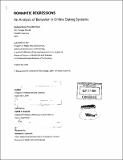| dc.contributor.advisor | Judith S. Donath. | en_US |
| dc.contributor.author | Fiore, Andrew Rocco Tresolini, 1979- | en_US |
| dc.contributor.other | Massachusetts Institute of Technology. Dept. of Architecture. Program in Media Arts and Sciences. | en_US |
| dc.date.accessioned | 2005-09-27T18:16:02Z | |
| dc.date.available | 2005-09-27T18:16:02Z | |
| dc.date.copyright | 2004 | en_US |
| dc.date.issued | 2004 | en_US |
| dc.identifier.uri | http://hdl.handle.net/1721.1/28773 | |
| dc.description | Thesis (S.M.)--Massachusetts Institute of Technology, School of Architecture and Planning, Program in Media Arts and Sciences, 2004. | en_US |
| dc.description | Includes bibliographical references (p. 65-68). | en_US |
| dc.description.abstract | Online personal advertisements have shed their stigma as matchmakers for the awkward to claim a prominent role in the social lives of millions of people. Web sites for online dating allow users to post lengthy personal ads, including text and photos; search the database of users for potential romantic partners; and contact other users through a private messaging system. This work begins with psychological and sociological perspectives on online dating and discusses the various types of online dating Web sites. Next, it presents an analysis of user behavior on one site in particular, which has more than 57,000 active users from the United States and Canada. A demographic description of the population is given, and then 250,000 messages exchanged by the active users over an eight-month period are analyzed. An examination of which characteristics are "bounding" finds that life course attributes such as marital status and whether one wants children are most likely to be the same across the two users in a dyadic interaction. To understand which characteristics are important to users in deciding whom to contact, regression models show the relative strength of a variety of attributes in predicting how many messages a user with those attributes will receive. By far the strongest predictor of messages received is the number of messages sent. For men, age, educational level, and self-rated physical attractiveness are the next most important qualities. For women, they are not being overweight, self-rated physical attractiveness, and having a photo. Finally, a discussion of the design implications of these findings and other design issues follow the results. | en_US |
| dc.description.statementofresponsibility | Andrew Rocco Tresolini Fiore. | en_US |
| dc.format.extent | 90 p. | en_US |
| dc.format.extent | 3084841 bytes | |
| dc.format.extent | 3094833 bytes | |
| dc.format.mimetype | application/pdf | |
| dc.format.mimetype | application/pdf | |
| dc.language.iso | en_US | |
| dc.publisher | Massachusetts Institute of Technology | en_US |
| dc.rights | M.I.T. theses are protected by copyright. They may be viewed from this source for any purpose, but reproduction or distribution in any format is prohibited without written permission. See provided URL for inquiries about permission. | en_US |
| dc.rights.uri | http://dspace.mit.edu/handle/1721.1/7582 | |
| dc.subject | Architecture. Program in Media Arts and Sciences. | en_US |
| dc.title | Romantic regressions : an analysis of behavior in online dating systems | en_US |
| dc.type | Thesis | en_US |
| dc.description.degree | S.M. | en_US |
| dc.contributor.department | Program in Media Arts and Sciences (Massachusetts Institute of Technology) | |
| dc.identifier.oclc | 60128830 | en_US |
